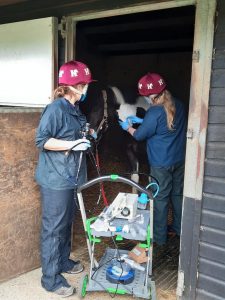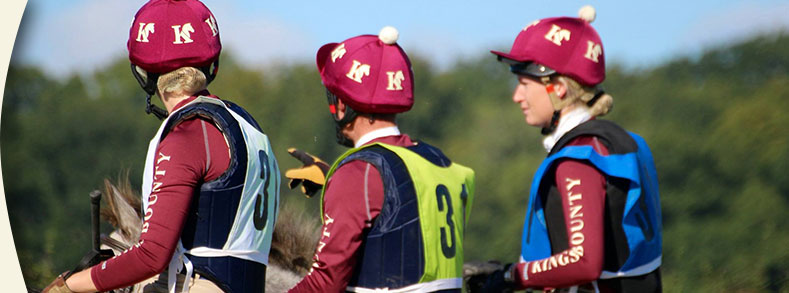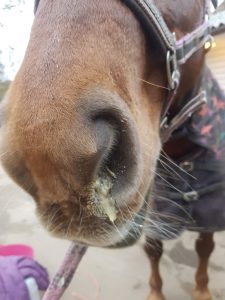Strangles is a highly contagious infectious disease caused by the bacteria called Streptococcus equi ssp. equi. The disease is rarely fatal, but can certainly be unpleasant, and is a major cause for concern in the horse industry due to the speed with which it spreads among horses.
It is a highly contagious bacteria that survives in carrier horses and can infect horses which come into contact with the carrier. In a large yard an outbreak may continue for months, effectively shutting down a premises.
Clinical Signs:
The severity of the clinical sings can vary hugely especially in populations that do not have immunity to the bacteria.
Infection is most common in 1-5 year olds but can occur in any age and generally once infected can develop a strong immunity – re infection is still possible however.
Infected horses will typically have an elevated temperature, (a very high temperature is characteristic of infection), causing them to become depressed and off their food.
A cough and a nasal discharge can develop and, in some cases, the lymph nodes around the throat will swell and develop into abscesses. This can cause the horse to have problems breathing and swallowing (hence the name ‘strangles’). Abscesses do not develop in all cases. They usually burst out approximately one week after infection but they can also burst inwards into the guttural pouches. The pus can then accumulate and dry out and remain in the pouch for years. (Known as chondroids).
In a small percentage of cases these abscesses can spread to lymph nodes in other parts of the body causing abscessation. This is known as ‘bastard strangles’ and is often fatal.
Transmission:
The bacteria can spread between horses through direct nose to nose contact, and indirectly via contaminated objects such as clothing, feed and water buckets and hands. The bacteria is not airborne but can survive in the environment for long periods of time. Most horses are no longer infectious within 6-8 weeks of resolution of clinical signs BUT.….
Carriers:
Some horses (approximately 1 in 10) can remain carriers of the disease for months or years after apparent ‘recovery’ from clinical signs, with the bacteria primarily located in the guttural pouches. The intermittent shedding of bacteria by these silent carriers is a significant cause of spread of infection to other horses. These carriers generally act as a source of further outbreaks. Horses with chondroids (balls of dried pus) in the guttural pouches will remain carriers until these are removed. This disease has to survive in infected carrier horses as it cannot survive long in the environment.
Diagnosis:
- The clinical signs are often indicative of the disease.
 The easiest way of seeing if a horse has been exposed to strangles is to check antibody levels in the blood. A horse will test positive on a blood test if it has been exposed to strangles in the 2 weeks to 6 months prior to the test OR if it is a ongoing carrier. It will have antibodies to the S. equi bacteria. It takes around 2 weeks for the antibody levels to develop.
The easiest way of seeing if a horse has been exposed to strangles is to check antibody levels in the blood. A horse will test positive on a blood test if it has been exposed to strangles in the 2 weeks to 6 months prior to the test OR if it is a ongoing carrier. It will have antibodies to the S. equi bacteria. It takes around 2 weeks for the antibody levels to develop.- In acute cases (less than 2 weeks) isolation of the bacteria using swabs taken from the nasopharynx (back of throat) or from a sample taken directly from the guttural pouches can confirm the diagnosis. So that infection is not missed, 3 swabs should be taken 5-7 days apart. A single sample from the guttural pouches is often more reliable. The lab will test these samples for strangles by trying to culture the bacteria and by running a PCR – this detects the DNA of the bacteria whether dead or alive and so it is a very sensitive test.
Treatment:
Treatment of strangles revolves around supportive care and good stable management. Once the lymph nodes have swollen and developed into abscesses, some will require surgical drainage and lavage. Some horses will require antibiotics however they are not indicated in many cases due to a number of disadvantages – they may prevent abscesses developing so disease carries on longer and they can increase the risk of abscesses developing elsewhere alongside preventing development of immunity. Antibiotics would be used in cases that develop other complications or infections at other sites.
Every case should be checked for carrier status at a minimum of four weeks after the resolution of clinical signs. To be confirmed free from the disease they must have 3 negative nasopharyngeal swabs, collected at weekly intervals, or 1 negative guttural pouch wash.
Control of infection:
Strict hygiene is essential in the face of an outbreak to minimise the spread of disease. The following measures should be taken:
- Infected horses and any suspected cases should be isolated immediately. Strict hygiene must be maintained at all times.
- Stop all movement of horses on and off the yard.
- All horses should have their temperature monitored daily, as an increase in temperature is the first clinical sign to develop, thereby allowing new cases to be identified and isolated quickly.
- Young and elderly horses are most susceptible to the disease and should be monitored closely.
- Rest stables or pastures that have housed infected horses for 4 weeks.
- Horses should not enter the premises during an outbreak unless they can be kept in strict isolation from all possible sources of infection. No infected or in-contact animals should be released from isolation until they have been tested (3 swabs or culture and PCR from guttural pouches) negative for both active infection and the silent carrier state.
- Advise that, ideally, now that we know that the blood test is not always accurate, guttural pouch washes are performed before arriving on to a new yard.
Please call the practice if you have any concerns or questions about this complex condition!













